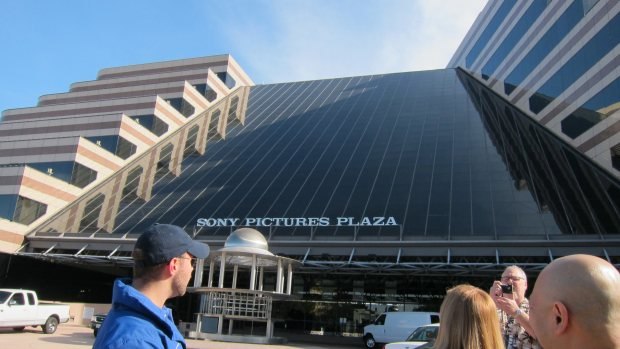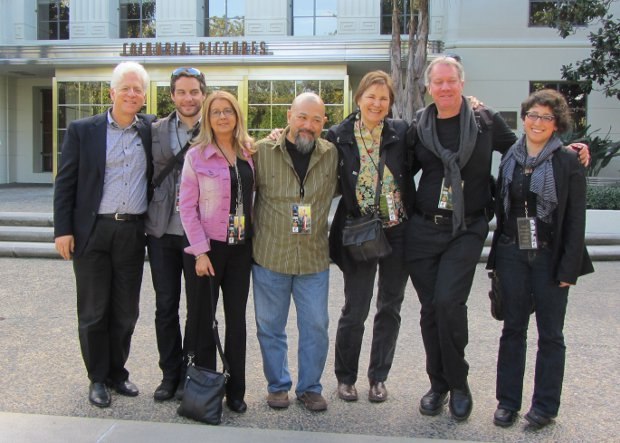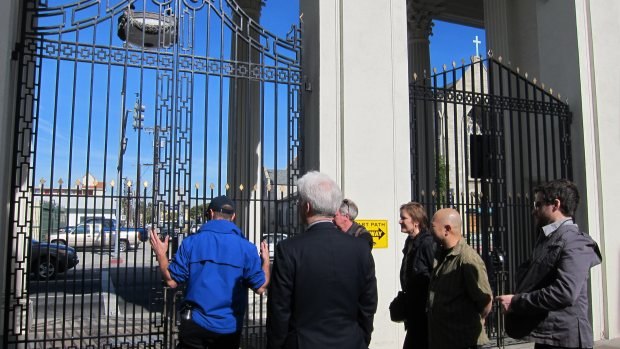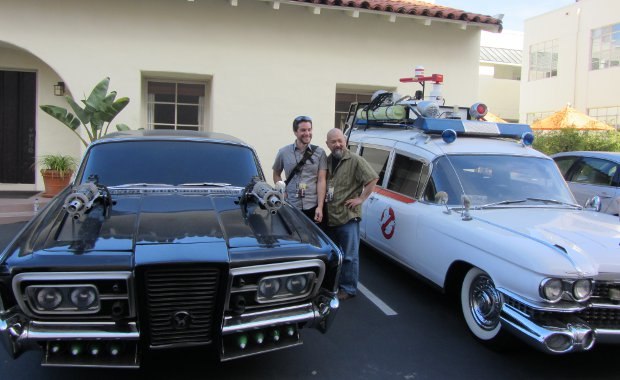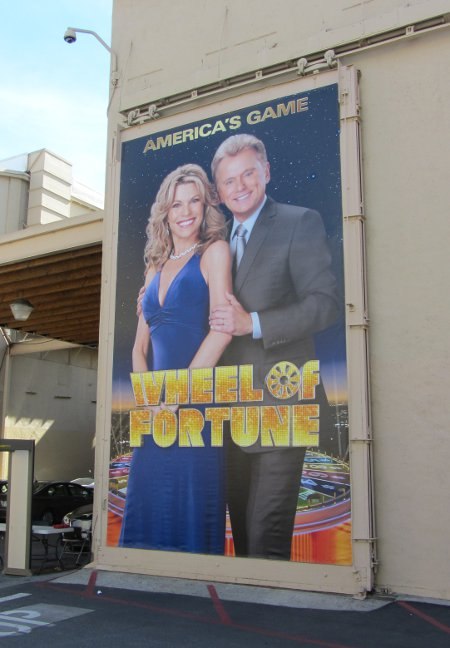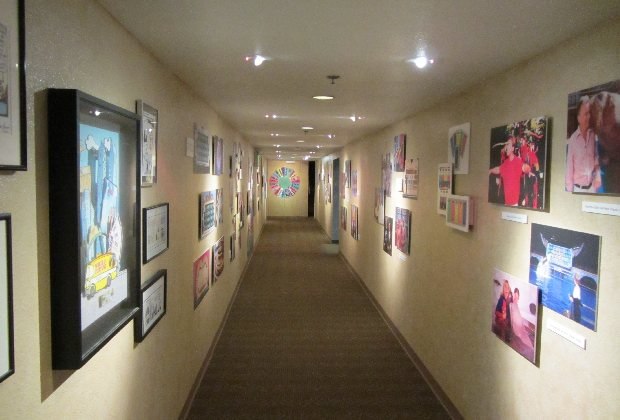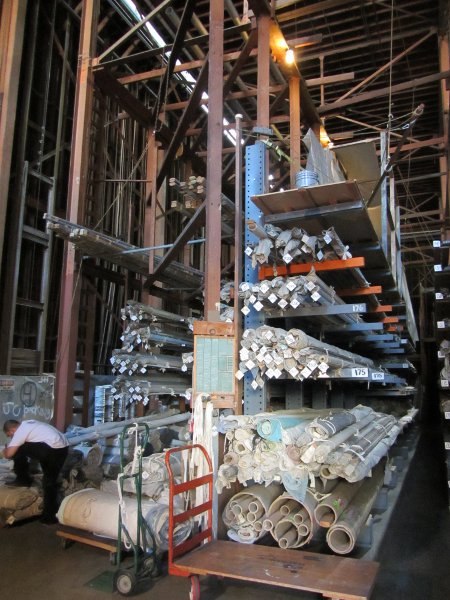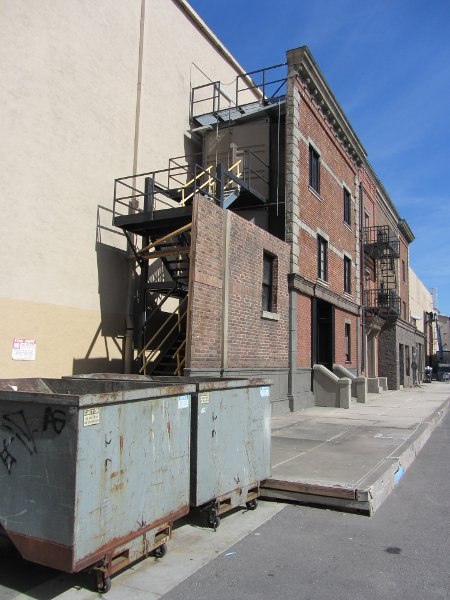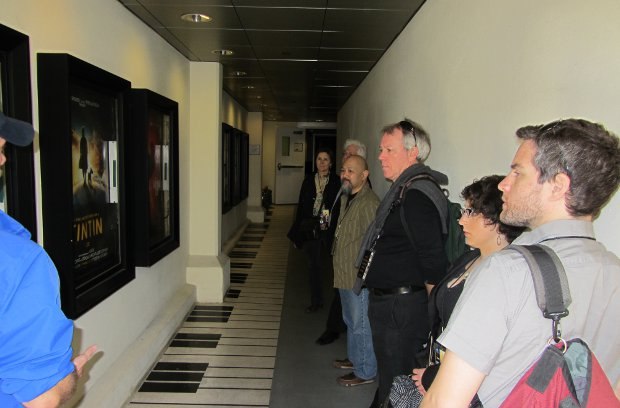Bright and early on Wednesday morning, the directors and producers from three of this year's Oscar-nominated animated shorts joined AWN and tour organizer Ron Diamond on the Sony Pictures studio lot.
By Zoe Chevat
Bright and early on Wednesday morning, the directors and producers from three of this year's Oscar-nominated animated shorts joined AWN and tour organizer Ron Diamond on the Sony Pictures studio lot. The nominees, some still recovering from jet lag, were nonetheless eager to see what another full day in Hollywood had in store for them. After a quick promotional video on the studio lot's history and its decades of hand-changing, the group was off, blue windbreaker-clad guide speeding us through screen legend past and present.
First up was the restored Deco facade of the Columbia Pictures building, once home to the plush, all-white office of famed producer Louis B. Mayer. Its lobby serves an equally illustrious purpose now; showcasing the studio's 12 Oscars, from 1934’s It Happened One Night up to 1987's win for The Last Emperor. Such splendor does not sit idle, either. As we were informed, this particular building, like many other administrative offices on the lot, has been used in the studio's productions. Take away the sign over the doorway, and you might recognize Peter Parker's high school from the first trilogy of Spider-Man movies. As one might expect, the lot is full of such pieces of film history both classic, and esoteric. We paused at the original MGM studio gates, kept in pristine condition, and protected by the city of Los Angeles as a historic landmark. Just past the familiar wrought-iron and gold were a couple things even more familiar to some; shooting cars from the Ghostbusters franchise, and the studio's recent Green Hornet.
These days, it's rare that new television shoots on the lot, particularly during this part of the season. Luckily for the nominees, returning series Breaking In was just beginning their day, and allowed us the privilege of standing in during a rehearsal and scene shoot. As with many productions, the few on-screen actors (in this case, stars Megan Mullally and Christian Slater) and extras are supported by massive crew hidden just off-camera, who lept into action as soon as the director yelled "cut". The set is complex and huge, an investment that allows directors for a particular episode to treat the built-to-specs rooms as one would a location shoot.
It's easy to be cynical about the future of television from the comfort of one's couch, but to be on set is as thrilling an experience as anyone has said. The old religion still retains its magic, transforming a collection of enormous concrete blocks into a place touched by both fantasy and nostalgia. Nostalgia in particular was on order as we headed over to the Wheel of Fortune stage, which shares the luxury of a permanent set, along with operating crew, with another longstanding TV staple, Jeopardy! The two daytime powerhouses have crammed shooting schedules; two week runs of shooting six real-time episodes a day for Wheel, five for Jeopardy! This can mean, as our group witnessed, a production meeting taking place on the Wheel stage while the other gameshow films just through the door.
Practical illusions are something of a specialty in entertainment, as readers well know. Though the world's gone largely digital in many ways, real sets, and real backdrops are still in demand. Just a few doors down from the busy soundstages is Sony's backdrop painting archive and workshop, currently housing company JC Backings. The massive shelves and painting floor, with its mechanized pulleys to move frames up and down, is largely as it was in the studio's golden era, and can accommodate up to 400 feet of painted backdrop. The company does do large-format photo processing for some modern jobs, but still manufactures traditional matte paintings for film and television. One example is the drop of a 360-view of JFK Airport's exterior they made for 2004's The Terminal, which, at 600 feet long, completely surrounded the set built in the middle of the desert. There's history to be found here beyond the movies, as well. As we were informed, the painting floor was employed to make battleship charts during World War II, and the warehouse's windows were blacked out to thwart potential spies.
Coming out of JC Backings, we passed the lot's largest soundstage, Stage 15, which stands next to the studio's (now largely defunct) water tower. The stage, the second largest in the world, is used infrequently, but has famously played host to films such as The Wizard of Oz, the first two Men in Black, Air Force One, and Spider-Man 1 & 2. It is currently being leased by an outside company, though no word on who's using the enormous space. Our tour guide helpfully supplied Sony's policy on renting, especially to competitors; "It's like an apartment. Once the client rents it, we don't go inside."
Last stop for Sony (but hardly for the day), was the Barbra Streisand Recording Stage. Still largely analog, with digital elements incorporated into the main board, the stage is preferred by film composers such as Danny Elfman, John Williams, and others, who like the space as much for its technical support as for the room’s unique sound character. The balsa wood paneling, much of it original, provides a slight reverb, an unusual feature for a sound stage. Hung throughout the main room are little nods and inside jokes that hint at sessions past; one John Lasseter Hawaiian shirt for every one of Pixar’s film’s scored in the room; an Enterprise model hung by J.J. Abrams for Star Trek; a bicycle stolen by engineers from a colleague as an admonishment for always being late and claiming someone stole his bicycle; and a mysterious dollar swinging from a fishhook, no doubt with a story behind it, as well.
Tempting as it was to linger, we had places to be and people to see. With a round of “thank-yous”, it was back in the cars and off to Sony Pictures Animation/Imageworks.
Dan Sarto is Publisher and Editor-in-Chief of Animation World Network.
